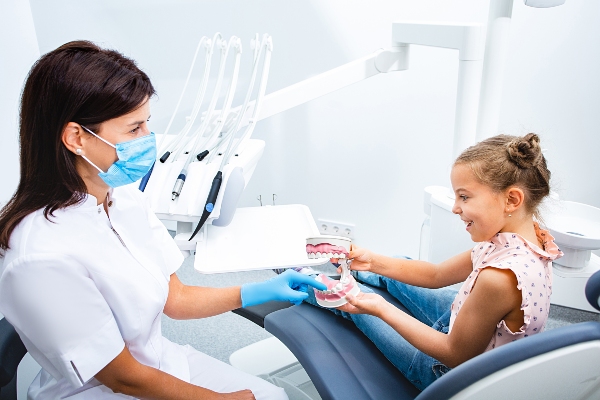How to Know if Your Child Needs a Baby Root Canal

A baby root canal is a restorative treatment that pediatric dentists use to save a primary tooth from severe decay or infection. While many parents are surprised that their little one needs a root canal, this procedure preserves the primary tooth. It also prevents further issues with a child's oral health and overall development associated with premature primary tooth loss. Understanding the signs that indicate the need for this procedure can help protect the future of your child's dental health.
Introducing baby root canals
A baby root canal, also known as a pulpotomy or pulpectomy, is a dental procedure performed to treat decay or infection in a primary tooth's pulp. The pulp is the inner portion of the tooth that contains nerves and blood vessels. When damaged or infected, this area can cause pain and further complications if left untreated.
A pediatric dentist performs the baby root canal by removing the infected portion of the pulp, disinfecting the area, and sealing the tooth to prevent further damage. They may also place a crown over it to protect it from decay. This procedure alleviates a child's dental pain while ensuring the primary tooth stays in the mouth until it naturally falls out, making way for the permanent tooth.
Why children need baby root canals
Primary teeth are essential to a child's oral health and development. They act as placeholders for their permanent teeth, maintain proper spacing, and protect the child's speech and chewing functions. When they lose a primary tooth prematurely due to decay or infection, it can lead to complications, such as:
Signs that a child may need a baby root canal
Detecting the need for a baby root canal involves looking for signs of pulp infection or damage. Some key signs and symptoms parents should be aware of include:
Persistent tooth pain
An ongoing toothache is usually an indicator of pulp damage and infection. If a child complains of constant discomfort, especially while eating or drinking, it may suggest that the decay has reached their tooth's pulp.
Temperature sensitivity
Increased sensitivity to hot or cold foods and beverages can be another sign of pulp damage. If the sensitivity does not subside after the initial exposure to temperature changes, the inner layers of the child's tooth may be affected.
Swelling and redness
Gum swelling or redness near the affected tooth may indicate an underlying oral infection. This symptom can be accompanied by tenderness or make it difficult for the child to chew their food. The child's cheeks or lymph nodes may also appear swollen.
Tooth discoloration
A tooth that appears darker or discolored compared to neighboring teeth may indicate internal damage to the tooth. This discoloration often occurs due to dental trauma or infection within the tooth's inner pulp.
A pimple-like bump on the gums
A small, pimple-like bump on the gum tissue near the affected tooth could indicate an abscess. This symptom may also cause a fever. A dental abscess is a serious tooth infection that requires immediate attention from a pediatric dentist.
- Shifting primary teeth
- Crowded primary or permanent teeth
- Damage to permanent teeth
- Difficulty chewing or eating
- Issues with speech development
Fortunately, a baby root canal allows the tooth to remain in place until it naturally falls out, ensuring its everyday functions are not disrupted.
Preventing the need for a baby root canal
Preventive care can significantly reduce the risk of decay and infection in a child's primary teeth. Parents should encourage their children to regularly brush and floss their teeth from a young age. They should also provide foods rich in nutrients like calcium, protein, and vitamins, which can toughen the child's teeth enamel and protect them from decay. Try to limit their consumption of sugary snacks and drinks, as these products can increase the risk of cavities and other damage to their teeth.
Additionally, children should go to their dentist regularly for checkups. The American Academy of Pediatric Dentistry (AAPD) recommends that children visit the dentist every six months for an exam and cleaning after their first dental visit. The first visit should occur by a child's first birthday or when their first tooth appears. A pediatric dentist will use these appointments to check the child's oral development and detect potential issues. They will also clean the child's teeth, removing plaque and tartar buildup in harder-to-reach areas. Most children
A baby root canal can protect your child's oral health
A baby root canal is an essential procedure to prevent your child from experiencing further pain and discomfort while protecting their future oral health and development. Do you have questions or concerns for us? Call the Memorial Pediatric Dentistry team to learn more or to schedule an appointment at our Houston office.
Request an appointment here: https://www.memorialpediatricdds.com or call Memorial Pediatric Dentistry at (281) 822-6600 for an appointment in our Houston office.
Check out what others are saying about our dental services on Yelp: Root Canal Treatment in Houston, TX.
Recent Posts
When you have little children, trips to the emergency room are common because their immune systems are not as developed, making them more susceptible to diseases, and the same applies to their oral care — especially if your child’s teeth are still growing — which means you should have an emergency pediatric dentist on speed…
Do you want some more information on the side effects of teeth grinding?If you suffer from teeth grinding, also known as teeth clenching and bruxism, then you need to learn more about the harmful effects of this condition. It is especially true if you think you are now starting to experience some of the many…
Wondering when a child should have their first pediatric dental checkup? Read on to learn more. Parents should prioritize their child's dental health. A part of that process is learning about the pediatric dental checkup and when to plan the child's first appointment. If your child is visiting the dentist for the first time, they…
Proper dental hygiene in children is as important, if not more so, than adults. Kids' dental hygiene and health can determine many factors about their dental health in the future, such as gum health, teeth placement and oral hygiene. Without proper care, a child’s dental routine could cause issues for them later in life. One…


